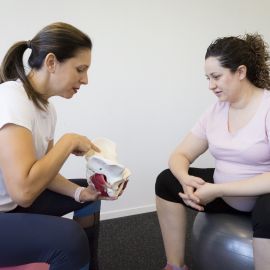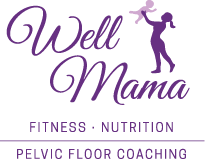
Pelvic Floor Recovery (Rückbildung)

Well Mama's 12-Week Pelvic Floor Training Programme
Well Mama works with a functional and medically recognised exercise programme designed to safely restore the function of the pelvic floor muscles.
The programme consists of 12 x 45min sessions designed to cover all aspects of the pelvic floor recovery process, and specifically designed to assist you in:
- Identifying the pelvic floor muscles through sensory awareness,
- Increasing your sensory awareness of the pelvic floor,
- Learning the correct breathing technique for optimal pelvic floor engagement,
- Protecting and strengthening your pelvic floor through everyday activities,
- Incorporating the correct pelvic floor engagement technique while undertaking fitness activities.
Why should you commit so much time to your pelvic floor?
The pelvic floor is intimately involved in all forms of movement and exercise. Yet, while we often commit time and effort to exercising many parts of our body to stay fit, few of us ever think about exercising the pelvic floor.
Pelvic floor disorders can have a huge negative impact on us not just physically, but also psychologically and socially. Evidence suggests that as many as one out of every five of us will suffer from some type of pelvic floor dysfunction at some point in our lives. So, if you're experiencing pelvic floor dysfunction related issues such as incontinence, lower back pain or organ prolapse, know that you’re not alone, and importantly, that it can be fixed. Most pelvic floor dysfunction issues can be resolved, if not greatly improved, by pelvic floor training.
Relying on doing squeezing exercises on your own is unfortunately unlikely to solve your pelvic floor issues. While Kegel exercises are still very popular and have their place in pelvic floor training, training the pelvic floor muscles in coordination with surrounding muscles is imperative to restoring its function. It requires learning the correct breathing techniques, working on your posture, training the entire abdominal compartment, also known as your core, as well as learning the suitable techniques to do simple everyday things such as lifting heavy objects or getting up from bed.
Just so as it takes time, determination and commitment to see results at the gym, the pelvic floor muscles are no different. Six-packs don’t appear magically, and so stopping yourself from leaking during a run will take some time and hard work too.
Some of the many benefits of regularly exercising your pelvic floor muscles include:
- Improved bladder and bowel control
- Reduced risk of prolapse (in women, this may be felt as a bulge in the vagina or a feeling of heaviness, discomfort, pulling, dragging or dropping)
- Increased sexual sensation and orgasmic potential, and
- Increased social confidence and quality of life.
Well Mama follows BeBo®'s (www.beckenboden.com) proven concept for Pelvic Floor Training. BeBo® is a leading health organisation with over twenty years' experience in the pelvic floor training and education areas.
Pregnancy and the pelvic floor
Statistics suggest that women, particularly those who have given birth, present the highest incidence of pelvic floor dysfunction. This is because pregnancy causes the muscles and ligaments in and around the pelvic floor to lengthen. Unlike popular belief however, women who have had C-sections are just as likely to have pelvic floor dysfunction as women who have had uncomplicated vaginal deliveries.
Diastasis Recti Prevention (Pre and Postnatal)
Often associated with the mummy-tummy, unfortunately there is a lot of misconception surrounding diastasis recti and abdominal exercise during and after pregnancy.
There is no proven way to completely prevent diastasis recti. However, the common consensus amongst doctors, health and fitness professionals nowadays, is that most women could benefit from keeping their “core” strong during pregnancy. By doing so you are helping support your pelvic organs, alleviate pressure on your lower back caused by pregnancy weight gain, and maintain correct body posture. A strong core is also believed to help you recover quicker after giving birth.
Strengthening your core requires learning to locate and activate your Transversus abdominis (TrA) muscle. TrA is our deepest abdominal muscle. It acts as our body's internal "girdle" and when contracted, compresses the abdominal wall. Most pregnant women can benefit from performing basic TrA exercises throughout pregnancy.
In the early postnatal period (from 6-weeks), abdominal recovery training (Rückbildungstraining) targeting deep postural muscles together with the pelvic floor will help you regain pelvic stability and encourage the separated abdominal muscles to shorten.
